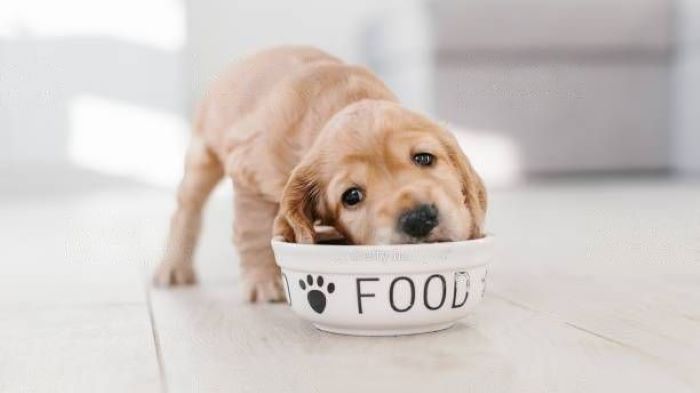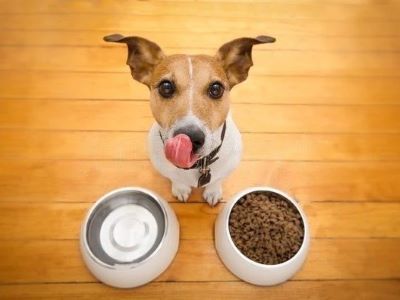Choosing the best dog food for your pet can be overwhelming. With so many brands and formulas on the market, how do you know which one is right for your furry friend? In this blog post, we’ll give you some tips on how to choose dog food.
Key Takeaways
- Always check the ingredient list and, according to your dog’s body requirements, select the meal for him.
- While purchasing, check whether the dog food manufacturer meets the nutritional guidelines provided by FEDIAF and PFMA.
- Dog’s nutrient needs vary as they grow, so different types of meals will be required to feed them.
- If you are confused about any meal, consult the vet, they will clear your doubt.

By the end of this post, you’ll be an expert in choosing the perfect food for your pooch! Here’s all you need to know about your dog’s food before you add it to his food section.
Keep reading, and make wise decisions in the future. Happy Shopping!
What to Consider When Choosing Dog Food?
Before purchasing food for your pup, it’s important to look at key points, which need to be there in your pup’s diet. We have jotted down essential points, have a look, and select your dog’s food wisely.
1. Essential Nutrients
Your dog’s meal should include essential nutrients in like protein, fats, carbohydrates, vitamins, and minerals in appropriate proportions. Its ratio varies as per your dog’s age, in different stages of life he requires a different diet for better development of his body.

So, it’s advisable to follow the vet’s prescribed diet chart, and accordingly, select the food on the basis of nutrients requirement. Your pup’s water intake ratio is very less, so if you opt for more wet food, it would be good for him.
Ryan Llera from VCAHospitals says that “Under normal circumstances, dogs can meet their nutritional needs by eating a combination of plant and animal foods.”
If you want to calculate the energy requirements of an average adult dog that lives inside your home, you should use the standard formula:
30 x weight in kg (or pounds divided by 2.2) + 70 = daily caloric needs
2. Age
We cannot deny the fact that dogs’ nutrient needs vary as per their age, like in different stages of a dog’s life they require different nutrients for better growth.

For instance, puppies grow up quickly, so they have to develop their muscles, bones, skin and fur, teeth and internal organs very rapidly. Getting the diet right from the beginning will set them up for a great growth period.
Puppies need the highest amount of protein immediately after weaning, but the amount will gradually decrease thereafter, according to Krista Williams of VCAHospitals. It’s important to know how much wet food to feed a dog at each stage. Puppies are typically weaned off of their mother’s milk at about 8 weeks of age.
After 12 months of age, a puppy can be switched to adult dog food. As per an article published in National Academies, “An adult dog’s daily diet can contain up to 50% carbohydrates by weight, including 2.5–4.5% from fibre”. It further states that at least 5.5% of the diet should come from fat and 10% from protein.
Similarly, senior dogs require meals which are enriched with essential nutrients so that their body can fight against diseases. Mark Nunez, DVM, says that dogs are usually considered to be old when they are half as old as they are expected to live. Hence, after this time, you should consider feeding senior dog food to your pooch.
Senior dog foods should usually have fewer carbohydrates, higher protein, and less sodium and calories. It is also good if it has ingredients like prebiotics or probiotics to keep a healthy population of intestinal microbes, omega-3 fatty acids and other antioxidants to fight inflammation, and glucosamine to keep joints healthy.
3. Size
Dog food is also classified as per their size, and breed type. Like, different ingredient sections are there as per dog size and breed. For instance, Great Dane growth is faster than compare to Pomeranian, so according to their growth they need food.

It has been observed that large dog breeds have slow metabolic rates. They take time in burning the calories as compared to small dog breeds, which means less calories food need to be fed.
As per VCA “The calcium content should be around 1.5% (or 3 grams/1,000 kcal). Large and giant breed pups should consume diets that contain at least 30% high quality protein and 9% fat (dry matter basis).”
On the other hand, small dog breeds have high metabolic rates, which means it doesn’t take time in burning calories. They require a calorie-dense meal, high in protein, and low in fat. Plus, feed them at least thrice a day for optimal growth.
Furthermore, also consider your furry pal’s diet, and then select food for him. Like if he is eating less then going for wet food, it will keep his tummy full, and will not ask for extra treats. Similarly, if your dog’s diet is heavy, then select treats accordingly, so that you don’t overfeed him.
4. Food Label
Before purchasing food for your pup, it’s important to check out the food labels. This is because most of the information is displayed on the package. All you need to do is read it carefully before adding it to the cart.
Key factors to look at:
- Brand and Product name
- Ingredients list
- Guaranteed Analysis, which includes exact nutrients value
- Calorie Statement
- Feeding guidelines
- Manufacturing, and expiry date
Ingredients to avoid:
- PROPYLENE GLYCOL
- ETHOXYQUIN
- BHT
- CORN SYRUP
- CARRAGEENAN
- BY-PRODUCTS
- FOOD DYES
- XYLITOL
Furthermore, avoid those packed meals which include wheat, corn, soy, etc. These are not safe for your dog’s health and can lead to health complications in the future.
When checking the food label, look for low sodium dog food options. Dogs with certain health conditions like heart disease may need to limit their sodium intake, so choosing low sodium varieties is important
5. Ask the Vet
No one will give you better advice than your dog’s vet. They conduct full body check-ups of your furry pal and make sure that you know each detail about your fido’s health.
According to your dog’s weight, and medical history, they will give you his diet routine, and the type of meal you should feed him. They will also give you an allergy chart, and food list you should avoid feeding him. All these tips will surely help you to select the right food for your dog.
Plus, if you are confused about any meal, consult the vet, they will clear your doubt about whether it’s good for your pooch’s health.
They will also give you recommendations if needed for specialty diets like the best wet dog food UK for dogs with allergies or sensitivities.
Checklist while choosing dog food:
- Make sure you choose dog food from the best of the best brands for your pooch. Almost all dog foods from reputed brands such as James Wellbeloved Adult Dog Food, Skinner’s Field & Trial Dog Food, Lily’s Kitchen Puppy Recipe Dog Food, IAMS For Vitality Senior Dry Dog Food,Ziwipeak Daily Dog Air Dried Dog Food, etc… will already be nutritionally balanced.
- Avoid food that contains a higher amounts of fillers.
- Decide as per your dog’s age, and health. Check out the ingredients list whether it’s allergic or not.
FAQs About How To Choose Dog Food?
What should you avoid in dog food?
When it comes to your dog’s food, there are a few things you’ll want to avoid. First, steer clear of any foods with artificial preservatives, flavours, or colours. These ingredients can be harmful to your dog and are often unnecessary. Second, avoid foods that contain by-products or fillers. These ingredients provide little nutritional value for your dog and can sometimes be harmful. Instead, look for foods that list whole ingredients like meat, vegetables, and fruits.
What vegetables dogs cannot eat?
Well, few vegetables are safe and even beneficial for your pooch. But on the other hand, there are vegetables that should be avoided by the pet parents like mushrooms, onions, garlic, tomatoes, potatoes, etc. These are not safe for your furry pal, they can also lead to digestion issues. And if chemicals are added during the plantation, then it can damage his organs also, so simply avoid feeding him vegetables which are not safe for him.
Do vets recommend grain-free dog food?
Some vets recommend grain-free diets, while others believe that grains are not necessarily bad for dogs. The bottom line is that you should consult with your vet to see what they recommend for your specific dog. Grain-free foods can sometimes be lower in nutrients than those with grains, so it’s important to choose food that is rich in protein and other nutrients. And, consider your dog’s individual needs. If your dog has allergies or sensitivities, a grain-free diet may be necessary.
Should I add water to dry dog food?
If your dog’s food looks dry and unappetizing, you may be tempted to add water to it. However, most experts recommend against this. Dry dog food is designed to be eaten as is, and adding water can interfere with the absorption of nutrients. If your dog is having trouble eating dry food, talk to your veterinarian about other options.
References:
- FEDIAF EuropeanPetFood. (n.d.). FEDIAF | Nutritional Guidelines. EuropeanPetFood. Retrieved November 17, 2022, from https://europeanpetfood.org/self-regulation/nutritional-guidelines/
- Pet Food Nutritional Resources — PFMA
- Callon, M. C., DeVries, T. J., & Shoveller, A. K. (2017). Canine Food Preference Assessment of Animal and Vegetable Ingredient-Based Diets Using Single-Pan Tests and Behavioral Observation. Frontiers in Veterinary Science. https://doi.org/10.3389/fvets.2017.00154



